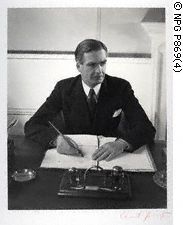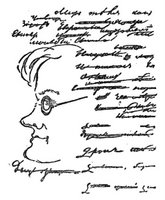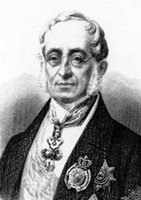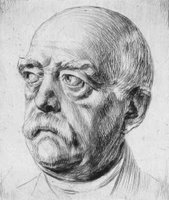'CONTENDING WITH KENNAN REDIVIVUS': A REVIEW OF 'GEORGE F. KENNAN: AN AMERICAN LIFE' BY JOHN LEWIS GADDIS
At the invitation of Mr. Danny Millum, the editor the Institute of Historical Research's online journal, 'Reviews in History', I penned the below review of John Lewis Gaddis' splendid biography of the diplomat and scholar George Frost Kennan. The man who qualifies in my mind to have been the greatest Foreign Service officer in 20th century American History. As I make clear, in some respects the amount of attention devoted to Kennan by my fellow diplomatic historians, is perhaps not fully justified by Kennan's historical importance qua a policy-maker. And as I make clear perhaps in my review I have not entirely escaped myself from the aura of George F. Kennan, 'cold war iconoclast' and Jamesian character. Someone who speaks for us all who are not entirely comfortable with American life and prefer in their heart and bones the once solid verities of so-called 'Old World', id est., Europe. As James noted in his study of the great 19th century American novelist, Hawthorne:
"If Hawthorne had been a young Englishman, or a young Frenchman of the same degree of genius, the same cast of mind, the same habits, his consciousness of the world around him would have been a very different affair; however obscure, however reserved, his own personal life, his sense of the life of his fellow-mortals would have been almost infinitely more various. The negative side of the spectacle on which Hawthorne looked out, in his contemplative saunterings and reveries, might, indeed, with a little ingenuity, be made almost ludicrous; one might enumerate the items of high civilization, as it exists in other countries, which are absent from the texture of American life, until it should become a wonder to know what was left.. No State, in the European sense of the word, and indeed barely a specific national name. No sovereign, no court, no personal loyalty, no aristocracy, no church, no clergy, no army, no diplomatic service, no country gentlemen, no palaces, no castles, nor manors, nor old country houses, nor parsonages, nor thatched cottages nor ivied ruins; no cathedrals, nor abbeys, nor little Norman churches; no great Universities nor public schools--no Oxford, nor Eton, nor Harrow; no literature, no novels, no museums, no pictures, no political society, no sporting class--no Epsom nor Ascot!"Which is not to gainsay the fact, that in his analysis of Sovietskaya Vlast, and in his early proposals to deal with the menace circa 1944-1946, Kennan outpaced all of his American contemporaries and many (but not all) of his British ones as well. Similarly, Kennan had the force of character to revise his initial views and policies to see that the only means of getting Sovietskaya Vlast to withdraw from Central Europe would be some sort of modus vivendi settlement, involving mutual withdrawals by both the Americans and the Russians. Unfortunately, by that time any such policy was infinitely more difficult to carry-out, as in the simplicity of mind that is the American Official Mind circa 1948-1949, only stark alternatives: a semi-militarized containment (later after Korea, fully militarized) or almost complete withdrawal from the containment. With nothing in between. Kennan's proposals both then and later suffered from the fact that they required a polity which was infinitely different from that obtaining in the USA, both then and now. Under the circumstances, it is not that surprising that within a few years Kennan was no longer in government service and had commenced his long road to inner emigre status. Given all that happened thereafter, one cannot blame the man in the least. That at any rate is some of what I endeavored to convey in my review of Gaddis opus. Given the fact that almost every primary source (at least in the USA) has been explored and exploited, there was not much new that Gaddis could exploited in that vein. Ideally of course, as I noted in my review it would have been worthwhile to have explored in much greater depth British and Russian sources as well as others (what about French views of Kennan circa 1946-1950?). As well as explored what if any similarities there were between say Kennan and his opposite numbers in the UK Foreign Office, like Sir Frank Roberts, among others. However, given those limitations, I felt and still feel that Gaddis' labour of love will withstand the test of time in being the outstanding and standard biographical study of Kennan's vita. Book: George F. Kennan: An American Life, by John Lewis Gaddis, New York, NY, Penguin Books, 2012, ISBN: 9780143122159; 784pp.; Price: £15.00
'No one knows what George Kennan really meant [to say]!’ So did the late McGeorge Bundy, my then professor, initiate me and a half a dozen other graduate students into mystery of George Frost Kennan. I say ‘mystery’ deliberately, as both at the time and later, there was indeed something distinctly odd about two aspects of the life and career of the one-time scholar-diplomat. First, what exactly were the policies that Kennan truly wished to advocate during his years in power at the American State Department in the mid to late 1940s? The second mystery consists of the amount of scholarly attention, devoted to this at times brilliant, but highly irascible and indeed almost eccentric, man. To give a pertinent example: more scholarly monographs and studies have been devoted to the life and career of Kennan then to any American Secretary of State in the 20th century, with the possible exception of Henry Kissinger.(1) Which, from a non-American perspective, might strike some as odd, given the fact that as a diplomat and public servant, Kennan can only be said to have occupied a position of the first-rank for a little over ten years: 1944–52 and 1961–3. It was, of course, during the first portion of Kennan’s official career, that he first achieved (and to his subsequent regret never quite managed to live-down) public renown as the ‘architect’ of the American policy of ‘containment’, the diplomatic strategy, which some (but never Kennan himself) claimed resulted in the eventual downfall of the Soviet Empire in Eastern Europe and eventually the Soviet Union itself. At the time that Bundy made his exclamation to us (in the fall of 1988), the first of the two mysteries relating to Kennan was well on its way to being answered, and the man who has provided most of it is none other than the author of this official biography, John Lewis Gaddis. A celebrated diplomatic historian himself in later years, it is not surprising that Kennan would choose (almost more than 30 years ago) as his official biographer the man who many perhaps (I myself being one of them) regard as the dean of 20th–century American diplomatic history. For the generation of historians of American diplomacy who were in graduate school in the 1980s and the 1990s, Gaddis was the most influential scholar in our historiographical patch. With a list of important journal articles and books, running from the groundbreaking ‘Was the Truman Doctrine a real turning point?’ to the magisterial ‘We now know’; Gaddis in many ways mapped out the whys and the wherefores of both post-1941 American foreign policy and the history of the Cold War. The book under review clearly shows on every page that it has been written by a scholar who has, in one way or the other, been living with this subject for about 45 years (Gaddis’ doctorial dissertation in 1968, on the origins of the Cold War, allots Kennan a prominent if secondary role).(2) Given the oceans of ink (much of which is Gaddis’ own) which has been spilled on Kennan what if anything new does Gaddis have to say about his subject? In terms of the substantive aspects of Kennan’s career, the answer is: not very much. And given, as mentioned, the voluminous scholarship already devoted to Kennan, as well as Kennan’s own autobiographical writings, perhaps this is not altogether surprising. This is not to gainsay the fact that Gaddis’ life will be, for the foreseeable future, the gold standard biographical treatment of this subject, but merely to state that given the reality that most of Kennan’s personal papers have been open to scholars for some years now, major surprises and revelations could hardly be expected. What, however, Gaddis does extraordinarily well is to present for the reader a series of in depth snapshots of the linear progression of Kennan’s life. From the lonely and motherless childhood in provincial Wisconsin to the even more lonely and now alienated college student at elite Princeton University, through to the young and still alienated American diplomat in Riga, Berlin and finally Moscow in the late 1920s and early to mid-1930s, holding what would appear in retrospect as a distinctly ‘un-American’ set of beliefs and points of view. From the now highly discontented (near resigning on several occasions) diplomat and budding Soviet expert, both at home and abroad; to the career-defining ‘long telegram’ from the Moscow in February 1946 and first head of the State Department’s Policy Planning Staff, to the equally career defining, ‘Mr. X’ article in the American periodical Foreign Affairs in July 1947, and from his gradual alienation and withdrawal from the seat of power through his many years as ‘Cold War iconoclast’ up to and indeed beyond 1989. In most respects Gaddis’s Kennan chimes with that of the man as previously known and explored. Where Gaddis’ biography shines, I think, is in delineating some of the remaining dark corners of Kennan’s personal odyssey (or given Kennan’s Calvinist beliefs, should we say ‘Pilgrim’s Progress’?), showing the alienated outsider who by force of nothing more than a combination of a brilliant intellect, a great prose style and (equally important as per Gaddis) a change of perspective by his superiors, became for a short time, a celebrated insider. Until Kennan once again, due to a combination of personal pique, diplomatic instincts and a different set of perspectives held by his superiors, reverted once more to the position of the alienated outsider, and eventually became a near heretic to the Cold War verities of official Washington. As per Gaddis, Kennan’s journey was of a piece with his at times tortured and self-critical personality. In the words of the American diplomatic historian, Lloyd Gardner, in George Frost Kennan ‘the Presbyterian Elder wrestled with the Bismarckian geo-politician’ (3), And according to Gaddis the former often overwhelmed the latter. Far from being eased, much less pushed out of the Policy Planning Staff by Secretary of State Dean Acheson in late 1949, it was Kennan who in essence engineered his own gradual removal from the seat of power, since according to Gaddis Kennan believed to be right was more important than to come out on top in some bureaucratic power struggle. This tendency for Kennan to be a pure intellectual manqué, is perhaps best exemplified by the contrast between Kennan and his successor as the Director of the Policy Planning Staff , the future arch-Cold Warrior, Paul Nitze, in terms of the advice they gave Acheson on the fraught question of whether or not the United States should develop a Hydrogen bomb in late 1949. Whereas Nitze (arguing in favor) submitted a two-and-a-half-page document which was a model of brevity and concision, Kennan (arguing against) produced a nearly 80-page document of verbose and moralistic, yet at times highly insightful, prose concerning the dangers of undue reliance on nuclear weapons . There was of course no contest between the two proposals. As Kennan later admitted, notwithstanding his characterization of his paper as ‘the most important of all the documents I ever wrote in government’, his advice was completely ignored (p. 379). As Gaddis succinctly puts it, Kennan ‘had become prophetic but no longer relevant’ (p. 381). Within three years, Kennan was to leave government service, never to return except for a short stint as John F. Kennedy’s ambassador to Yugoslavia, a posting which Gaddis painfully shows brought Kennan little pleasure and much grief. With that being the case, perhaps there is no surprise that Gaddis devotes approximately half of this almost 700-page book to Kennan’s private existence as a scholar, and occasional commentator on public affairs. During this period Kennan won such honors as the Pulitzer Prize (twice) and the Bancroft (once) awards. Finally, he covers Kennan’s years as a Cold War gadfly (or to his harsher critics essentially a crank) and as an almost internal émigré, utterly alienated in his detestation of contemporary American civilization. On this issue, I must enter one of my few caveats with Gaddis’s opus: the subtitle of the book was chosen, one assumes, with some care in order to disparage the idea that Kennan was a Henry James character, more European than the Europeans and having little American about him. According to Gaddis, Kennan’s frequent claims to be un-American are nothing more than a form of mental irritation, and thus not to be taken seriously. Still, one scarcely can think of any public figure in American life in the last century or more, who would put pen to paper and argued (albeit privately) that the United States should adopt aspects of a European dictatorial and authoritarian governance ( specifically the Dollfuss & Schuschnigg regime in Austria), as Kennan did in the 1930s. As Walter Hixson archly noted in his own Kennan biography, Kennan’s ideas were, ironically enough, closer to those of the Soviet regime which he thoroughly detested than to those of his own native country.(4)To attribute Kennan’s alienation and detestation of American society and governance as merely forms of eccentricity with nothing substantive behind them, seems to belie the importance of and indeed seriousness of Gaddis’ subject. Another minor caveat with this first-rate study concerns the realm of ideas. Specifically, where exactly did Kennan acquire that mishmash of ideas and concepts which was to be transformed into what became later known as the international relations theory of ‘realism’? Did Kennan obtain them via exposure to Bismarckian concepts during his two years as a student-diplomat in Berlin, Kennan being the only foreign service officer in the Russian section of the State Department to be sent to Berlin as opposed to London or Paris?(5) Gaddis does not tell us, nor does he even investigate this aspect or any related aspects of Kennan’s intellectual formation and development as a budding diplomat and Soviet expert. Indeed, the only author that Gaddis mentions who was an influence on Kennan in the years prior to his ‘long telegram’ was Edward Gibbon. To give another example, in a letter to the Hungarian émigré historian, John Lukacs, in 1984 (not quoted in Gaddis’ book), Kennan stated that the British writer-diplomat, Sir Harold Nicolson, was ‘his model of the diplomatic historian’.(6) Whether true or not, I would think that this statement would be worthy of investigation in an almost 700-page book. Certainly this is an area for further research by any future biographer of Kennan. Finally, the somewhat esoteric realm of Kennan studies could I believe stand a degree of greater of exposure to extra-American sources and indeed comparisons. While Gaddis does use some British and Russian primary source materials, one has the impression that this was more of an afterthought than anything else. Similarly, it would have been interesting to have compared and contrasted Kennan’s views on the Soviet Union during the war, with those of, say, the UK’s Post-Hostilities Planning Sub-Committee. In light of the fact that the views of both were remarkably similar, what does that tell us the nature of Western perceptions of the Soviet Union in the latter part of the War? And, given the similarity, could Kennan’s unique antennae, as they related to Stalin’s Russia, have been truly that singular?(7) That being said, can we say that Gaddis answers the second of the two mysteries of George Kennan, namely why the overwhelming scholarly devotion to this rather curious and unusual man? The answer is yes: for Gaddis, Kennan was in reality a teacher and a first-rate scholar more than he was anything else, whether he was engaged in diplomacy at the time or not. And perhaps it is this sense of Kennan as a kindred spirit which perhaps more than anything else explains the fascination exercised by him over academics and historians. He is in short, whether we agree with his record as a policy planner, ‘one of us’. The brilliance of Gaddis’s book consists of conveying this insight to his readers. He deserves many thanks from all of us for this labour of love.Notes
1.For the best known studies, see: David Allan Mayers, George Kennan and the dilemmas of U.S. Foreign Policy (New York, NY, 1988); Walter Hixson, George F. Kennan: Cold War Iconoclast (New York, NY, 1989); Anders Stephanson, Kennan and the Art of Foreign Policy (Cambridge, 1989); Barton Gellman, Contending with Kennan: Towards a Philosophy of American Power (New York, NY, 1984); Wilson Miscamble, C.S.C, George F. Kennan and the Making of American Foreign Policy, 1947–1950 (Princeton, NJ, 1992). John Lukacs, George Kennan: A study of Character (New Haven, NJ, 2007).Back to (1)2.John Lewis Gaddis, ‘Was the Truman Doctrine a real turning point?’, Foreign Affairs, 53 (January 1974), 386–402; John Lewis Gaddis, We Now Know (Oxford, 1997). The dissertation was eventually made into a book (The United States and the Origins of the Cold War, 1941–1947), which won the Bancroft Award in 1972.Back to (2)3.Lloyd Gardner, Architects of Illusion (Chicago, IL, 1970), p. 285.Back to (3)
4.Hixson, op. cit., p. 7. Stephanson in his idiosyncratic if at times illuminating study gets it about right when he says that Kennan circa 1940 was a: ‘radically conservative man, bordering on the reactionary’. See: Stephanson, op. cit., p. 117. See also Kennan’s frequent comments about his detestation and alienation from America and American life over a good number of years in Through the History of the Cold War: The Correspondence of George F. Kennan and John Lukacs, ed. John Lukacs (Philadelphia, PA, 2010), pp. 91–92, 106–110 and passim. The Henry James comparison was first made by Gardner, op. cit., p. 278.Back to (4)
5.This point is made in a study of the 'official mind' of Kennan's generational cohort of American diplomats. See Hugh DeSantis, The Diplomacy of Silence: The American Foreign Service, the Soviet Union and the Origins of the Cold War, 1933-1947 (Chicago, IL, 1980), p. 29, where it is noted that he was ‘exposed to his teachers’ realpolitik view of international affairs as well as the intellectual current of Weimar Germany, which pulled against the dominant stream of liberalism’. Other than Kennan there were only six other American diplomats who received the specialized European study course, before the programme was discontinued. See T. Michael Ruddy, The Cautious Diplomat: Charles E. Bohlen and the Soviet Union, 1929–1969 (Kent, OH, 1986), p. 3.Back to (5)
6.Lukacs, Through the History of the Cold War, p. 100.Back to (6)
7.The Foreign Office and the Kremlin: British Documents on Anglo-Soviet Relations, 1941–1945, ed. Graham Ross (Cambridge, 1984), pp. 147–155, 157–171.Back to (7)
Dr Charles G. V. Coutinho, review of George F. Kennan: An American Life, (review no. 1397) URL: http://www.history.ac.uk/reviews/review/1397 Date accessed: 28 March, 2013











0 Comments:
Post a Comment
<< Home